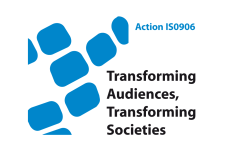- About the Action
- Events
- PhD workshop - Ljubljana 2014
- Action Open Conference - Ljubljana 2014
- New Media and Participation conference - Istanbul 2013
- Belgrade meeting 2013
- Media literacy research and policy - Brussels 2013
- ICA Pre-Conference 2013
- Tampere meeting 2013
- Budapest workshop 2012
- Milan meeting 2012
- Brussels PhD workshop 2012
- Brussels Action workshop 2012
- London meeting 2011
- Zagreb Conference 2011
- Lisbon meeting 2010
- Affiliated events
- WG 1
- WG 2
- WG 3
- WG 4
- Cross-WG
- Output
Transforming newswork, transforming audiences: Call for newsroom ethnography in contemporary audience research
Vobic, I. (2011). Transforming newswork, transforming audiences: Call for newsroom ethnography in contemporary audience research . Zagreb conference: "New challenges and methodological innovations in European media audience research". 7-9 April 2011.
Abstract: The paper argues that ethnographic insights into messy newsroom environment are needed for the contextualization of the audience’s role in the process of news production. Issues concerning news production have been traditionally focused on the systemic and structural level and have maintained a fixation with content and reception analysis, often neglecting ethnographic approaches, which investigate processes where social subjects make decisions that an observer can trace and identify articulations among journalism, culture and society on the micro level. Social, cultural and technological changes in contemporary journalism have facilitated new patterns in the relationship between journalists and the audience, expanding and transforming modes of audience involvement in the news, and calling for various methodological paths in audience research. Since journalism’s fundamental role in democracy is to link citizens to political life, exploring how journalists construct an entity of people engaged in news and how journalists involve members of the audience in news is important for grasping dynamisms of heterogeneous, fragmented, and individualized audiences and their roles in news production. Furthermore, within respective epistemological framework connections among news production, technology and identity are particular and non-necessary, they can be forged and broken in particular circumstances, vary in their tenacity and in their relative power within different configurations, and different articulations empower different possibilities for journalists in constructing news and the audience. Thus, newsrooms as spaces for decision making in the development of journalism, where routines, values, relations, entities, and products are tested and created are regarded as central research environments. It appears that newsroom ethnography approach can be useful empirical companion in audience research in the contemporary media world, where power is moving away from the journalists as gatekeepers over to what the audience knows and various modes of audience involvement in news production process brings further uneasiness into journalists’ relationship with the audience.

